Hello everyone, I just completed my second to last week interning in the Jin Lab at Scripps Research in neuroscience. This week has gone by unbelievably fast and I can’t believe I’m almost done. It’s hard to believe that by this time next week, I’ll be on my way home.
There wasn’t much to do on Monday this week, my mentor had some car trouble and couldn’t come so I was on my own for the day. I went to a lab meeting in the morning and did some more neuron tracing in the afternoon.
On Tuesday my mentor transfected some cells to use for a qPCR later on. She also showed me how to use the tapestation. I’ve watched her use the tapestation before but it measures concentrations of DNA (similar to the nanodrop but more accurate). I labeled neurons in the afternoon.
On Wednesday I was able to passage adherent cells using trypsin, otherwise known as cell splitting. I watched my mentor do this on my first or second day so it’s really cool that I am able to do it now. Cell splitting is done in the tissue culture hood and allows you to detach adherent cell cultures which allows for easy resuspension during cell harvesting. The cells start out in Petri dishes full of media, in the petri dish they are adhered to the walls of the dish and each other. Once your cells are in the TC hood you aspirate the media and add trypsin to the plate. Trypsin works to cleave the peptides that attach the cells to the walls of the dish and leave them free floating. The plates with trypsin are incubated for around 5 minutes and then most of the trypsin is removed. You then take a new petri dish and fill it with media that keeps the cells alive, you then move your desired amount of cells to the new petri dish and put the dish in the incubator for your desired amount of time. Intermittently throughout the process you move the plates from the TC hood to a microscope. You can see the cells that are dead, the cells that are cleaved, and the cells that are still stuck to the wall. The computer was booked on Wednesday so I didn’t label any neurons but I did watch a presentation about tissue regeneration in the late afternoon.
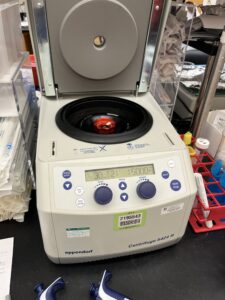
This is the centrifuge I used to spin the wash buffer through the DNA I collected during gel extraction. You always have to make sure to balance your centrifuge, if they aren’t balanced the start violently shaking and sound like airplanes.
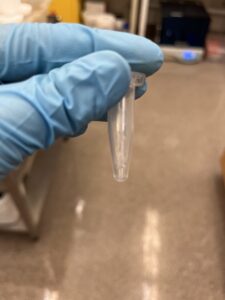
This is my tube with the gel band I cut from my electrophoresis. We extracted the DNA from this band.
On Thursday I had to attend a Zoom training in the morning and didn’t get to work until 11. Once I got there I ran a PCR and then ran the PCR on an E-gel. We wanted the DNA from the E-gel so I cracked open the plastic edge and cut out the band we wanted and then extracted the DNA from the gel. I helped my mentor do this last week but I was able to do it pretty much on my own this week. I also finished labeling a neuron image.
Friday was a pretty busy day, we are preparing to run a qPCR (which will happen next Monday) the qPCR will tell us if the CRISPR-Cas9 knockout (knockout of a specific gene) worked. I started in the TC hood with cell lysis, cell lysis breaks down the cell membrane to expose the DNA, RNA, organelles, and other parts of the cell. after the lysis we did a reverse transcription, which is meant to convert RNA or mRNA to complementary DNA or cDNA, the reverse transcription was followed by a PCR. While the PCR was running I helped my mentor run the tapestation (a machine that accurately measures the concentration of a sample) on the sample that I extracted on Thursday. After the PCR was done I put it in the 4-degree fridge where it’ll stay till Monday.
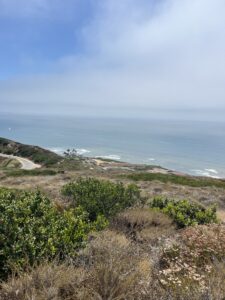 On Saturday Katie and I went to Cabrillo National Monument, the monument overlooks the entire San Diego Bay and skyline, it also has a collection of tidepools that you can walk to when the tide is low. We also learned that the San Diego Museum of Art is free to anyone 17 or under so we went to see the art. That evening we decided to get dressed up and go out to eat to celebrate our last week of work and our last weekend to explore San Diego.
On Saturday Katie and I went to Cabrillo National Monument, the monument overlooks the entire San Diego Bay and skyline, it also has a collection of tidepools that you can walk to when the tide is low. We also learned that the San Diego Museum of Art is free to anyone 17 or under so we went to see the art. That evening we decided to get dressed up and go out to eat to celebrate our last week of work and our last weekend to explore San Diego.
That has been it for my 5th week in San Diego. I know that there are some exciting things happening next week so be sure to come back for those!
-Siena

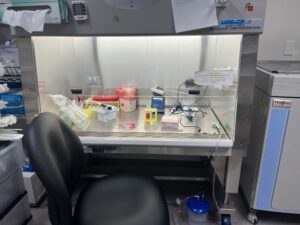
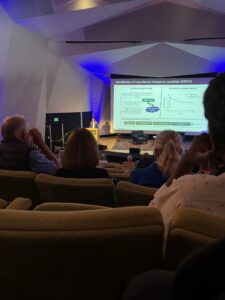
Siena- Wow! You have been doing some amazing work. I am so impressed with what you are doing…extracting DNA and splitting cells. I so enjoy reading your blogs. Enjoy all of it!